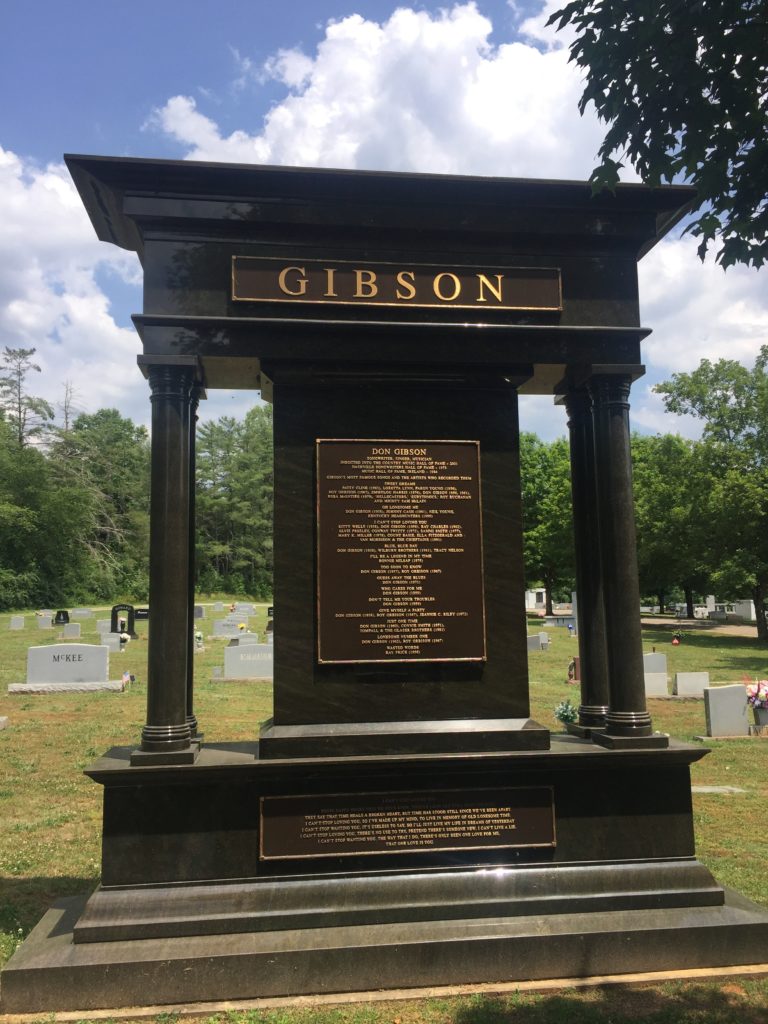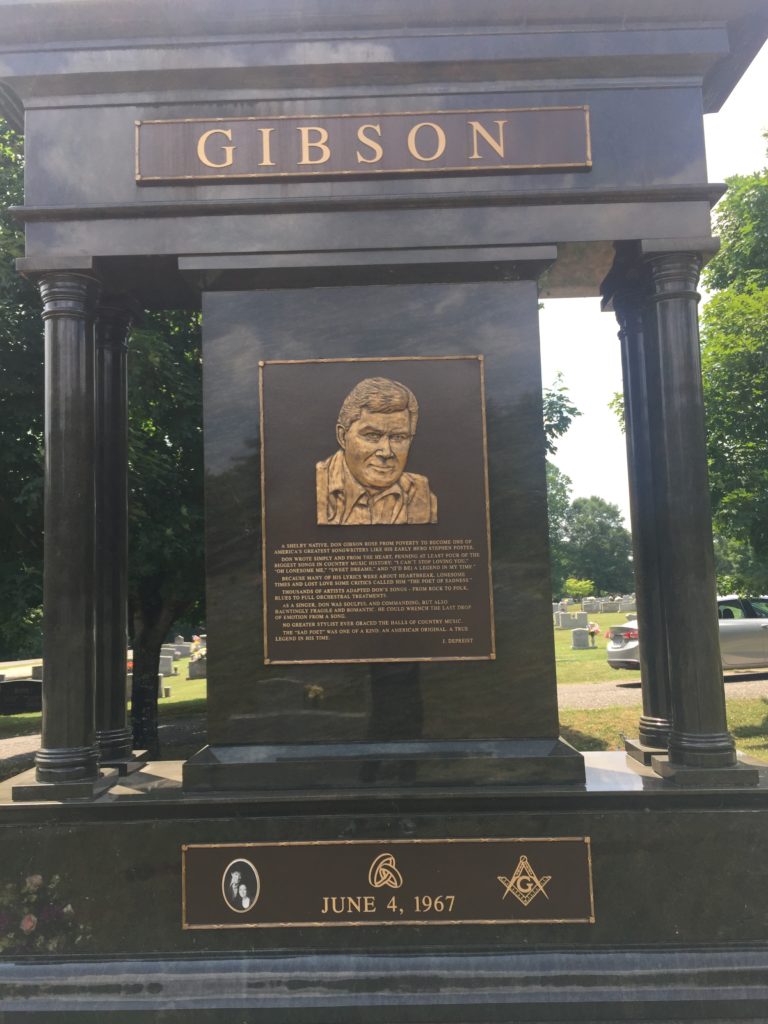Erik Visits an American Grave, Part 1,034
This is the grave of Don Gibson.


Born in 1928 in Shelby, North Carolina, Gibson grew up dirt poor. Like, his family had absolutely nothing. Sharecroppers. His last year of school was the second grade. But he learned the guitar. Like many poor southern families, music was central to life. It was also his ticket out of poverty.
In 1949, Gibson started selling his songs. With his band Sons of the Soil, he started recording on Mercury after they had a successful run on a local radio station. That was a common way that country bands got known in these days. Doing commercial bits and having 15 or 30 minute shows was a way for stations to fill time and also to tap into what was often a pretty deep well of local talent, though not usually as talented as Gibson. His first cut was his song “Automatic Mama.” He soon moved to Knoxville, Tennessee and got a job with WNOX, which was an important regional radio station. He was recording for Columbia by then and although he was a very good songwriter, his early cuts did not sell well. He managed getting this contract when Fred Rose heard him and was impressed enough to offer a writing contract, but Gibson had the wherewithal to say he wanted a recording contract too. But these struggles weren’t real uncommon, even for talented people. He also struggled a bit to connect with audiences. He was more of a crooner. While this would soon become dominant in country music–Marty Robbins, Ray Price, etc.–at this time, making it required playing honky tonks with rough crowds who wanted rough music–Hank Williams, Jimmie Rodgers, etc. He didn’t quite fit. So it was a slow rise for Gibson.
By the late 1950s, the Nashville Sound was dominant in country music. While it often gets a bad rap from people who think A MAN WITH HIS GUITAR is the only proper way country music should sound, that smoother set of production techniques and lush instrumentation worked better for some artists than others. For Gibson, it helped pull him over the top. Recording with Chet Atkins in 1957, he cut his two most famous songs, “Oh Lonesome Me” and “I Can’t Stop Loving You.” These are two of the iconic tracks in country music history, both of which have been covered far and wide. The legend at least, which Gibson pretty much pushed, is that he wrote both of those songs one afternoon in Knoxville when he was living in trailer, drinking way too much, and had some appliance taking back by the repo man. Even when country music was extremely uncool in the rock world, Neil Young was covering “Oh Lonesome Me” for After the Gold Rush. “I Can’t Stop Loving You” became a big hit for Ray Charles in his country cover album phase. Gibson followed these hits up in 1961 with “Sea of Heartbreak,” another all-time classic that you might best know from Johnny Cash’s pretty good cover on it on the second American Recordings album. Another song of Gibson’s that you probably really did not know was his is “Sweet Dreams,” which Patsy Cline had a huge hit with in 1963. Faron Young also hit big with that song. These songs were not only huge sellers, but at this time, Atkins’ production techniques were still pretty new. Gibson had long played with your traditional instrumentation that included the fiddle and steel guitar. Atkins convinced him to try and record these songs without that and instead with piano and background singers. It was a huge hit for both of them, launching Atkins into the upper echelon of producers and Gibson into a major country star.
Gibson wrote sad songs. Sad songs really are the core of country music. Yeah sure, people like to dance and party. But at the core, it’s sad songs. George Jones for instance would record just enough upbeat tunes to get people to buy an album so he could record as many sad songs as possible. Gibson was the same way. He said about his music:
My songs are simple, and just about all of them are about love. I write about people, not things. I never had a lot of education, and I don’t feel easy with words. Most of the words to my songs are real simple. I just make them up to put to some tune on the guitar I’ve come up with. It’s the sound of the guitar that I’ve always been interested in.
Gibson’s style definitely did not hold up well to the late 60s musical changes. He also had managed to drink and pill pop his way to the verge of oblivion ever since at least the late 50s. But he managed to remain a pretty important figure on the country music scene. He did a bunch of duet albums with Dottie West, who herself was a long underrated artists and mostly forgotten today except among hard-core country albums. He also adjusted to the rhinestone cowboy era of the 70s, which I think is underrated. His 1972 hit “Woman (Sensuous Woman) is a bit cheesy, but also a really good song. However, Gibson was personally a very shy man. He was not a good stage persona. He wanted the songs and his voice to speak for themselves–fair enough. George Jones faced this same problem, which contributed to his massive boozing. This was also a problem for Gibson. While he mostly stopped overconsuming after he married in the early 70s, that didn’t mean his moderate stage fright wasn’t a thing. He pretty much stopped performing by the 80s and basically disappeared from the country scene outside of an occasional Opry appearance.
In 1973, Gibson was elected into the Nashville Songwriters Hall of Fame. In 2001, the Country Music Hall of Fame called his name and inducted him.
Gibson died in Nashville in 2003, at the age of 75.
Let’s listen to some Don Gibson.
Damn, now that’s some country music.
Don Gibson is buried in Sunset Cemetery, Shelby, North Carolina.
If you would like this series to visit more members of the Country Music Hall of Fame, you can donate to cover the required expenses here. 2001 was a hell of a class for the HOF. Among them, Waylon Jennings is in Mesa, Arizona and Phil Everly is in Central City, Kentucky. Previous posts in this series are archived here.


